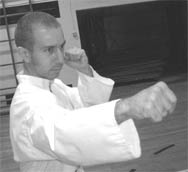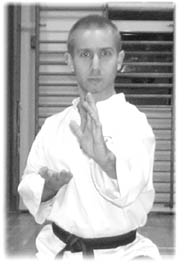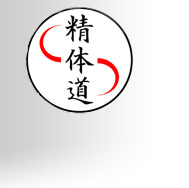Home Page
Site Map
Members
Tech Guide Index
Class venues and times
Goyararu FAQs
Goyararu Martial Arts
Goyararu Classes
Example Techniques
Photo gallery
Movies
Goyararu Instructor
gokarate.co.uk Links
Beginners lessons
Email us
© Bushi Goyararu Association




|
Goya-Ra-Ru Martial Arts (Birmingham, West Midlands, UK).
- Technical guides for training members
Goya-Ra-Ru Competitive Freestyle
Introduction
The practice of freestyle enables us to become more familiar with offensive and defensive techniques and their use against an actual person. Balance, speed, creativeness and observation skills are improved. We learn to adapt to each opponent and their unique style and it helps sharpen our reactions in order that our responses become more automatic and less laboured.
As martial artists we become very fast and powerful during the course of our continued training and learn to throw punches and kicks capable of disabling an opponent. This power must of course be controlled when training with fellow practitioners and so a high level of accuracy and control should be obtained in order that training members can enjoy safe, stress-free bouts and feel able to experiment with different techniques and strategies without fear of injury.
This type of freestyle allows for the sporting element of competition but at the same time is strictly controlled by a series of rules. In this way, fast action-packed bouts can be enjoyed by skilled martial artists who walk away free of injury.
Competitive freestyle should not be thought of as trying to mimic an actual fight or confrontation and doesn�t compare to the very different emotional response and �no rules� reality of a genuine confrontation.
It can be thought of as a contest between two people in which each uses their skills to score a point against their opponent whilst conforming to the rules of the bout. After a while, practitioners will develop their ability to:
1) Predict an opponents attack
2) Adapt to different opponents and their strategies
3) Develop strategies
4) Adapt classical martial arts techniques for a freestyle environment
5) Obtain an idea of how techniques may work in a real situation
Bouts may be conducted within a special arena. This is usually a square with two starting lines marked inside. A third party (judge/referee) starts and stops the contest and awards points where appropriate. However, competitive freestyle is commonly performed more informally during a normal lesson format between two experienced martial artists.
Scoring Points
Contestants can employ their full repertoire of techniques in order to score a point except those that are considered to involve an unacceptable risk of injury (see section on forbidden techniques).
The main qualities of a scored point are technique, control and target area. Full points are awarded for attacks that satisfy all the following requirements:
1) The technique must be controlled such that it:
a) touches the opponent in a controlled manner so as not to cause injury, or
b) does not necessarily make contact but does penetrate the opponents defences
2) The technique must be realistic enough so that if delivered in actual combat it would cause injury or render the opponent incapable of continuing.
3) The target area must be to one of the accepted vulnerable parts of the body.
If a technique satisfies only 2 of these requirements then a half point may be awarded. No points are awarded for techniques that satisfy only one requirement. If an uncontrolled powerful technique makes hard contact with the opponent through no fault of the latter, the contestant may be disqualified and lose the bout.
Techniques that do and do not qualify as point scoring are as follows:
1) Hand and leg techniques except incorrect techniques such as the quick light �flick� movements of the open hand qualify.
2) Ankle and leg sweeps constitute a point only if followed by a point scoring technique.
3) Techniques caught or trapped constitute a point only if the �catcher� follows with a point scoring technique.
4) Line Points:
a) Points scored on the line with one of the opponent�s feet outside the arena constitute a point.
b) Points scored on the line with both of the opponents feet outside the arena do not.
Freestyle Adaptations of Classical Techniques
In general, it is possible to modify many of the classical techniques used in the normal training drills to make them more suitable to this type of freestyle. This is done for two reasons:
1) To further reduce the risk of injuries. One example would be in exposing the flat of the foot when delivering a side-kick rather than the edge of heel. This way, if unintentional hard contact were to be made the effects would be less severe. Hard blocks using the bony areas of the forearms should also be substituted for those that redirect the attacker�s energy such as palming attacking blows away.
2) To more effectively penetrate an opponent�s defences. For example, using the freestyle variants of the front kick, side kick, round and reverse-round kicks, which can be quicker and more difficult to block.
In addition, the classical stepping moves and long stances are generally dropped in favour of shorter stances and steps similar to those used by a boxer. Any steps which involve crossing the legs in front of each other should ideally be avoided.
It should be noted however, that techniques adapted too heavily just for speed such as light open handed strikes will not score a point.
Acceptable Target Areas
The front, side and back of the main body trunk area are acceptable target areas. The side and back of the neck and head area are also acceptable but practitioners must be very careful when directing strikes towards these areas. Techniques to the leg, thigh, buttocks and the outside surfaces of arms and shoulders do not score a point.
Forbidden Techniques
For safety reasons, techniques to the following areas are not allowed:
1) front of the face
2) throat
3) knee area
4) groin area
Downwards classical cutting techniques to the head, neck or shoulder, are also forbidden. For example the classical axe-kick should be adapted to the freestyle version.
Spinning upper body techniques (e.g. spinning back-fist) and strikes to the back of the head and neck should be discouraged for less experienced practitioners.
The conditions (e.g. hard floor) may also make it wise to disallow tripping techniques.
Attacking and Defending
Some points to remember when attacking are as follows:
1) Techniques must be delivered in range so that they are capable of scoring a point.
2) Single technique attacks are not very effective against a well guarded target. It may therefore be necessary to create an open target area by the use of dummy attacks. However, a dummy may actually get through so it is worth making these realistic enough to be capable of scoring at least a half point if not blocked.
3) After the attack (or even during) be mindful of counter attacks and try to keep guarded.
4) Landing off-balance after an attack will quickly be exploited by a skilled opponent.
5) When attacking, it�s possible that you are yourself at your most vulnerable. The same also applies to your opponent of course.
Defending against an opponents attack can either be done by;
(a) moving out of range,
(b) blocking the attack,
or combinations of both (a) and (b).
Ideally, when defending against an opponents attack you should aim to reposition yourself in range to deliver your own techniques and your opponent less able to deliver secondary attacks.
Competition and Referee
The Art of Goya-Ra-Ru, as it is currently practiced would not be described as a 'sports' or competition based martial art. However, from time to time, events are organised that allow students to test their skills in a competitive environment. Competition rules may vary with regards to the time limit, number points to decide the winner and whether or not half points are awarded. These rules are stated in advance of the competition.
As an example, the winner may be decided as the first person to score 3 clear points and a sensible time limit may be around 3 minutes. Extra time or first-to-score rules may be used for bouts that take longer than the set limit where nobody has scored.
The referee will start the bout and stop it when:
1) A point is scored
2) A competitor steps outside the arena
3) The time limit is over
4) The bout becomes uncontrolled or the referee wishes to make comment, make a warning or disqualify a competitor.
Following a stoppage, the competitors return to there starting marks in the middle of the arena. If appropriate the referee will raise there hand in the direction of the person who scored the point and again to signal the winner of the bout.
It is unavoidable that, techniques will be delivered on the referee�s �blind-side� or that he may simply miss a point due to its speed. During fast bouts it may be particularly difficult to detect all scoring points. For this reason, four judges or marshals are placed at the corners of the area to assist the referee. They may carry different colour flags appropriate to each competitor which they hold up to indicate if in their opinion a point has been scored. It is in each competitor�s best interest to make their points as obvious to the referee as possible.
Clothing and equipment
Although serious injuries are extremely rare, certain protective equipment is advised to minimise the effects of minor clashes and �knocks� that inevitably occur if freestyle is continued long enough. A groin protector, shin pads and protective gloves should be worn. Gum-shields may be worn but are generally not necessary as techniques are not deliberately directed towards the front of the face and should also be controlled in any instance.
For competition, the full gi should be worn. One competitor may also be required to wear a coloured sash as indicated by the marshal�s flags.
Safety
When practiced correctly, Goya-Ra-Ru competitive freestyle can be very enjoyable and allows for a sporting element while at the same time developing many of the skills of a martial artist. The techniques themselves are of course faster and consequently potentially more powerful than those used in compromised freestyle. This type of freestyle is therefore much more strictly controlled at least to students relatively new to the martial arts.
Injuries in Goya-Ra-Ru freestyle are very rare. Several factors are used in order to achieve this:
1) Limitation of target areas (especially techniques to front of the face).
2) The use of non-contact or semi-contact rules.
3) It is only practiced by the more experienced martial artists who have demonstrated competence in basic techniques and compromised freestyle.
Those practitioners with injuries or conditions that may be aggravated by competitive freestyle practice need not take part or may modify the bouts to a �semi-competitive� level.
Advanced Freestyle Performance
Injuries can potentially occur where practitioners allow themselves to become tense and nervous. This also has the effect of reducing their performance. However, it is hoped that with continued practice, people eventually begin to realise that they are not going to get hurt and begin to relax. Their techniques then become much better and more adventurous. Once this barrier has been overcome, progression can be made without free of the fears and inhibitions that can hold practitioners back.
Ultimately, students should not attempt to rush into competitive freestyle before they have developed a good level of compromised freestyle. It is much more involved than it appears. Initially, the ultimate goal of this type of freestyle is mistaken as a sporting activity to score points. However, on this level it can become nothing more than a glorified �tag� game. Potentially it offers much more.
Competitive freestyle is an activity for technically skilled martial artists and as a result takes time to learn and to perform well. However, the rewards of taking the time to do this are well worth it. It is an activity which constantly throws up new challenges as new and more skilled opponents are encountered. It can therefore even force you to adapt your whole repertoire of techniques where you may have otherwise stuck with your comfortable favourite ones. It also gives individuals the chance to adapt and invent new techniques and counter attacks as apart from the forbidden techniques and target areas mentioned above, there are few restrictions to limit the imagination.
Club Directory
| General Information
| Goya-Ra-Ru Martial Arts
| Lesson Format
| Technique Examples
| Martial Arts Instructors
| Moseley Goyararu Martial Arts Club
| Quinton Goyararu Martial Arts Club
| Quinton Karate Junior Club
| Photographs:[ 1 |
2 |
3 |
4 |
5 ]
| Training Fees
| Class Etiquette
| Beginners Sessions
| Links Page
| Link to gokarate.co.uk
| Side Kick
| Round Kick
| Projects
| Bushi Goya-Ra-Ru Association
| Site Map
|




